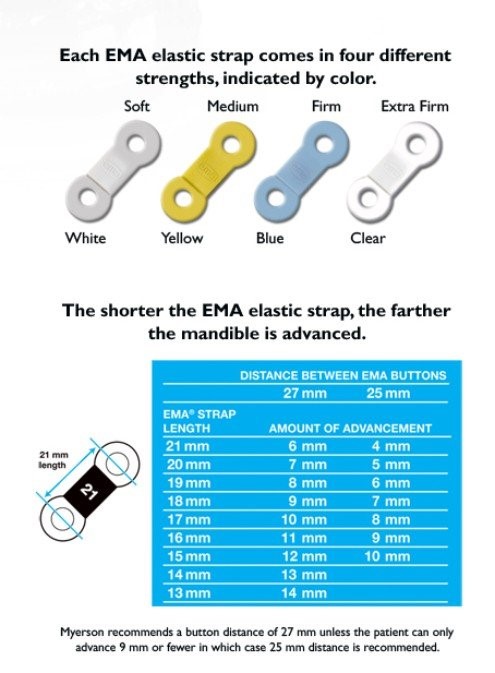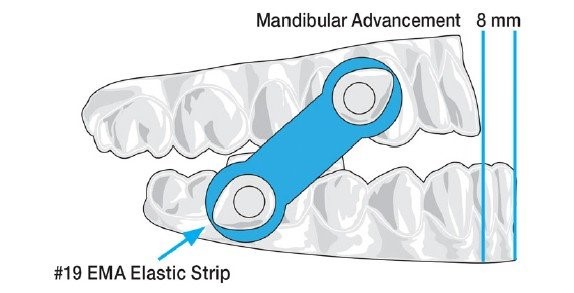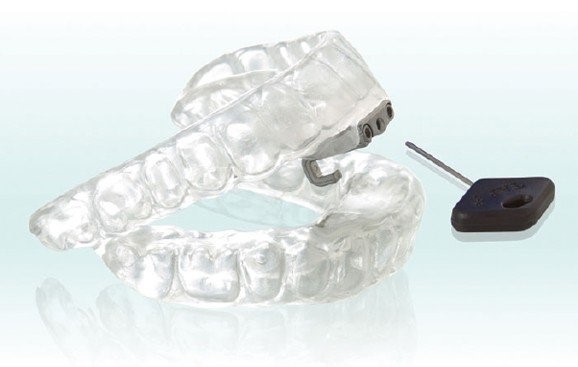Our Alternative to CPAP
The traditional treatment for sleep apnea has been the CPAP device, and it remains the gold standard for moderate to severe sleep apnea. CPAP stands for Continuous Positive Air Pressure. The patient is fitted with a machine that pumps a continuous stream of air into the patient’s nose or mouth throughout the night. However, many people find this uncomfortable, and they stop wearing the mask. Ideally, at Arlington Smile Center, we would like to help patients work towards increasing their airway to correct the apnea. Often, however, a patient just wants a way to reduce the apnea while they sleep and are not looking for a solution.



Myosa® Sleep Correction Appliance
The Myosa range of intraoral appliances are designed to provide practitioners with an effective means of treating their patients’ sleep-disordered breathing (SDB), TMJ disorders and teeth grinding. Rather than just focus on alleviating the symptoms of SDB, the Myosa appliance range aims to treat poor myofunctional habits (oral habits) as well as the upper airway and neuromuscular dysfunction, which can cause SDB. Treatment with oral appliances is now considered to be the most convenient way to alleviate sleep-disordered breathing. The Myosa appliance range functions by posturing the lower jaw slightly forward, correcting tongue position and opening the bite, which then opens the airway and regulates breathing. Additionally, the Myosa system is focused on encouraging people to play an active role in their own treatment.
When in place, the Myosa for Snorers appliance will open the airway and control over-breathing through the mouth. The appliance’s flexible sides with air spring base minimize impact on the jaw joint (TMJ), making it also suitable for users who suffer from TMJ disorder or grind their teeth. Rather than just focus on alleviating the symptoms of the problem, the appliance aims to correct the upper airway and neuromuscular dysfunction, which can cause sleep-disordered breathing. The Myosa for Snorers (S1 and S2) appliances function by posturing the lower jaw forward and opening the bite, which works to open the airway and regulate breathing.
How do I get sleep apnea insurance coverage?
When a patient needs a mandibular advancement appliance for sleep apnea, usually dental insurance does not cover it. However, if you send a copy of your sleep study and a prescription from your physician recommending an appliance, most medical insurance will cover the appliance. But it is subject to your deductible.
Medical Billing Codes for Dental Sleep Medicine:
ICD-10 Diagnosis Code for Obstructive Sleep Apnea: G47.33
Obstructive Sleep Apnea (Adult) (Pediatric)
CPT Code for Sleep Apnea Custom Oral Appliance: E0486
Oral device/appliance used to reduce upper airway collapsibility, adjustable or nonadjustable, custom fabricated, includes fitting and adjustment.
When using the above E0486 code, most insurers require modifier NU (new equipment). Medicare requires modifier KX showing specific documentation.
How do I use these codes?
Every medical claim form needs at least one diagnosis code and one procedure code. In a dental sleep medicine medical claim, the diagnosis (diagnosed by a physician, as dentists cannot diagnose obstructive sleep apnea) would be obstructive sleep apnea, denoted by the ICD code G47.33. The procedure would be oral appliance therapy with a custom-made oral appliance, denoted by the CPT code E0486.
What else do I need to know?
Dentists can also bill for the exam and any radiographs performed during the obstructive sleep apnea exam. In addition to having the right codes, successful dental sleep medical billing requires several pieces of documentation before the claim will be paid. These vary depending on your insurance company but can include:
- The diagnosis of obstructive sleep apnea by a physician
- A written order or prescription for an oral appliance from a physician
- Patient questionnaire that includes medical history, Epworth sleepiness scale and sleep history
- Detailed documentation or narrative report of questionnaire data and exam findings.
Snoring and sleep apnea don’t have to fill your nights. Give us a call today at 703-237-7622 for a consultation with Dr. Roca.
